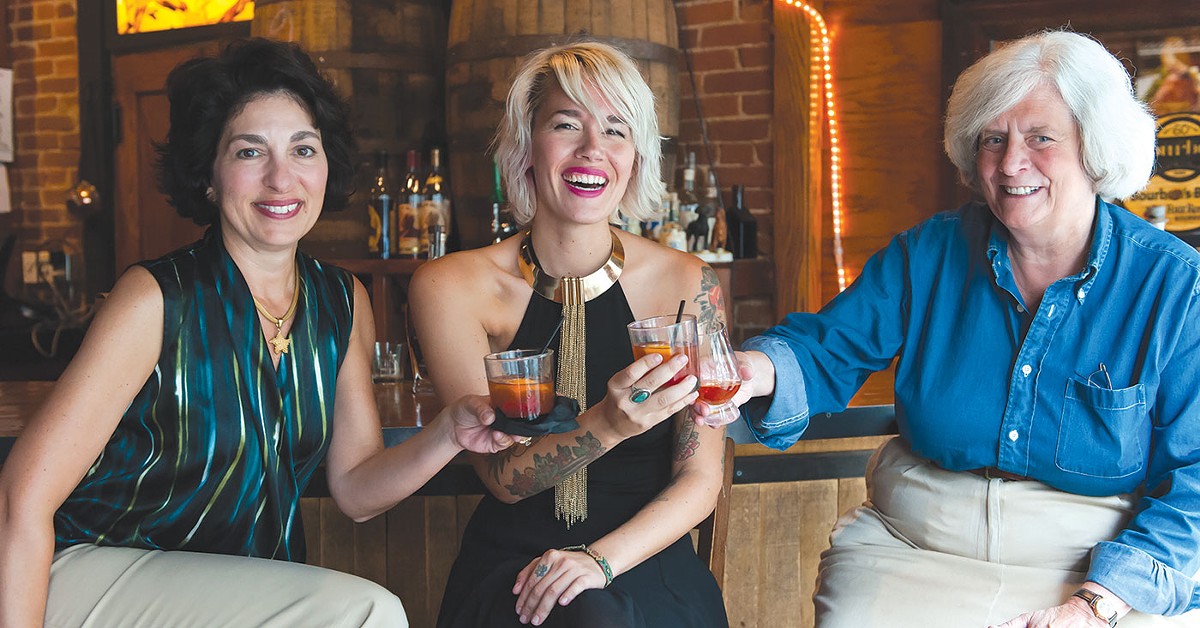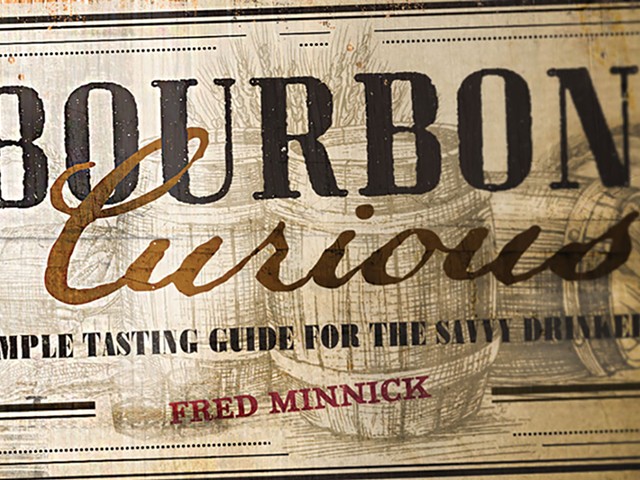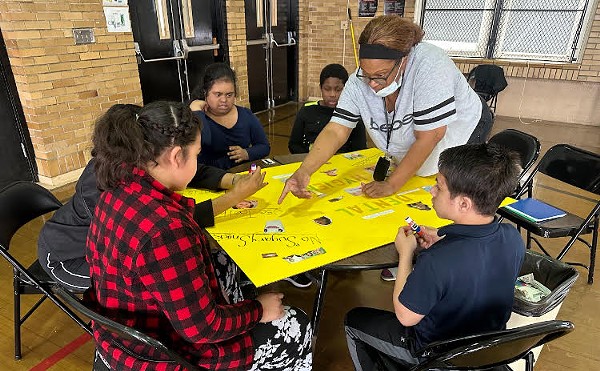Occasionally, when I bring the utmost deeply American amber nectar that we call bourbon to my lips, my mind will wander to thoughts of the originators. Unbeknownst even to themselves, they were symphonists, creating and aligning an orchestra, solely by marrying their corn crops — their livelihood — with Kentucky limestone water and allowing them to coexist, to mingle, to intimately steep within a charred white oak barrel. Two hundred years ago, did they know how bourbon would make us feel today? For some, it’s a warm embrace around a rural campfire amongst comrades. For others, it’s a delightful few cubes of ice in a highball at a bar in NuLu encircled by vintage vinyl. For me, it’s a Mad Men-esque easy confidence in a neat pour that creates a sensory experience that seems to have been extracted from the sacred limestone residing in the depths of Mammoth Cave’s winding, sweating walls. Perhaps it’s actually Jennifer Lawrence’s breast milk, who knows?
As Kentuckians, bourbon’s history lies intrinsically within us all, and for the first time since the mid-70s, we can be proud that bourbon is outselling vodka at a rapid incline. According to our current industry power players, the bourbon boom is here to stay, thanks to the blood, sweat and tears of those before us, and the passion, palates and enthusiasm of those among us.
Sitting down for bourbons with Fred Minnick is almost like transcending time through the American experience, falling somewhere between whiskey’s fiery frontier and the Roaring 20s. Delightfully well-dressed in a grey suit, thick-rimmed glasses and a patterned ascot (“always an ascot,” he says), we bellied up to the Silver Dollar’s abundantly whiskey-adorned bar. With an easy prowess, Fred chose the Henry McKenna Single Barrel Private Selection, aged eleven years and four months, and hand-selected for the Silver Dollar in 2013, for us to enjoy. While Minnick humbly calls himself a bourbon writer over a historian, he has truly “crawled inside the archives” of our great spirit to write “Whiskey Women: The Untold Story of How Women Saved Bourbon, Scotch, and Irish Whiskey” (2013), and now “Bourbon Curious” (2015). Among his many talents in the industry, Minnick has written for Whisky Magazine, Whisky Advocate, been a judge at the World Whiskies Awards and the San Francisco World Spirits Competition, among other esteemed achievements. Needless to say, I’m toasting with the epicenter of this man’s milieu.
“When you look at this, when you smell it and taste it,” Minnick says, gazing lovingly at the two-finger pour of caramel-colored liquid in his hand, “that minute to three-minute experience is every bit as enjoyable as a bite of a brownie; it hits all the senses.” He explains that as a country of extremes, we aren’t accustomed to actually enjoying the flavors of alcohol, but rather drinking it for its effects. Once we begin to taste the layers and nuances of bourbon, we can also breach the binders of its history and understand that our ancestors in the Bluegrass were actually the ones to plant the proverbial seed of America’s spirit. That’s a splash of pastime you can taste, and according to Minnick, millennial palates have caught on.
While bourbon is predicted to be on a 20- to 30-year upswing in sales above white spirits, Minnick feels that true Kentucky gumption will outlast any trend, “In Kentucky, you have passion, history and money pumping out fantastic whiskey,” he says, “and millenials are seeking flavor.” Minnick credits bourbon’s current boom to young people adhering to trends in the food and beverage world — in a time that sitting down to dinner includes a craft cocktail getting Instagrammed and hashtagged before the first sip, consumers want divine quality, something the bourbon industry unwaveringly provides.
Since Minnick wrote “Whiskey Women” in 2013, he’s often been asked, as a man, why? Truth be told, while on military duty in Iraq, he found the women in his infantry outperformed the men on their tour. “It is fascinating what women can do, despite society oppressing them,” he says, and when it came down to bourbon whiskey, the information was buried in dust-ridden boxes, stories anxiously waiting to be told. “Women don’t have the same egos as men,” he says. “They don’t want whiskies to be named after them; they don’t want all the credit.” And truly, how many whiskies can you find named after a woman? Yeah, me either. Finally, Minnick also began his research for “Whiskey Women” because he wanted to fact check the interest group, Bourbon Women, who claim that women were at the forefront of bourbon distilling, production and marketing. Turns out, they were right.
The women of bourbon
Peggy Noe Stevens and Susan Reigler of Bourbon Women exude class and confidence. It’s hard not to feel like you’re amongst royalty whilst sipping bourbon with such influential women in the realm of our state’s great potion. Noe Stevens, akin to Booker Noe himself, “grew up with bourbon,” yet, in true queen fashion, felt the need to establish herself, on her own, in the world of bourbon. That she did, as she worked in the industry for Brown-Forman for 17 years, became a competitive taster and then became the first-ever female Master Bourbon Taster in the world. In 2010, she co-founded the group Bourbon Women, of which Reigler is the current president. Reigler, co-author of “The Kentucky Bourbon Cocktail Book” (volumes 1 & 2) and “The Bourbon Tasting Notebook,” a former food critic for the Courier-Journal and leader of bourbon tastings from “Seattle to Savannah.” The ladies and I bellied up to Bourbon’s Bistro to enjoy an Elijah Craig 21 Year for Susan, and an Elijah Craig Old Fashioned for Peggy and myself.According to Noe Stevens and Reigler, it’s a huge misconception that women don’t drink bourbon. “Several years ago, I was conducting bourbon tastings to female-dominated crowds, and women were the ones asking questions,” says Noe Stevens. “Strong whiskey (marketing) is aimed towards men,” which simply isn’t fair, considering the fact that, thanks to Bourbon Women focus-group findings, women like higher proof and more robust spirits. “Physiologically speaking, we have more sophisticated palates,” she says, sipping her Old Fashioned cocktail.
“Three-quarters of our members enjoy bourbon neat or on the rocks,” says Reigler about Bourbon Women, whose membership exceeds 700 members. She echoes Minnick’s beliefs regarding bourbon’s recent rise in the world of spirits, “Bourbon has such wonderful food descriptors,” which consumers, particularly women, flock towards, including the “familiar flavors of vanilla, caramel and chocolate.” Bourbon Women, founded in 2010, was established as a platform for women. “When you teach someone how to enjoy a spirit, it becomes approachable,” says Noe Stevens.
Currently, Bourbon Women hosts year-round events and has recently expanded membership to new branches in Chicago and Indianapolis, with members in 26 states and 4 countries. When asked if Bourbon Women maintained a specific demographic, the answer was a firm ‘no,’ “but there is a psycho-graphic,” says Noe Stevens, “meaning our members all seem to be confident, professional, carry a certain bravado and an interest in soft adventure.” Bourbon Women had their most recent event this month, a “Sip-posium” at The Pendennis Club, which notoriously did not allow women until the mid-80s. “Do you find it ironic to host a women’s club event at such a place?” I ask Noe Stevens. “Ironic, or did we do it on purpose?” she replies, with a coy smile. Excuse me while I get a tad misty with Bluegrass feminist pride.
Speaking of waving the flag for all women, America’s 15th state recently gained our first female master distiller in the bourbon whiskey industry since Prohibition, and she’s an energetic 28-year-old with a palate far more developed than her years. Marianne Barnes, who hails from a chemical engineering background and worked her way up from an internship at Brown-Forman to Master Taster for Woodford Reserve, has recently taken up shop at the historic former grounds of the Old Taylor distillery in Millville, Kentucky. Barnes carries a quiet and endearing confidence, and her knowledge will surely put any skepticism regarding a female master distiller to rest. “I’ve always known I would go into a male-dominated field,” says Barnes, sipping a neat pour of Four Roses Single Barrel. “I’ve never felt like I stuck out because the industry has been so warm and welcoming.”
The brand that now inhabits the beautiful former grounds of Old Taylor, which will go public with its new identity in September and begin distribution in early January, is Barnes’ baby. “It feels like home there,” she says. “I’m passionate about being open and honest about ingredients,” which Barnes says includes a local heritage variety of white corn, hybrid rye and more. When Barnes first began her internship at Brown-Forman, she claims she didn’t even have a taste for bourbon, which gives hope to those that may want to love Kentucky’s famous brown water but haven’t found their liking yet. “I’m a bourbon purist at heart,” she says, and she credits Woodford Reserved Double Oaked with creating her true love affair. Barnes suggests, to develop a palate for bourbon, begin with cocktails, and she attributes a large part of the rise of the bourbon industry to the passion within bartenders and mixologists: “I love the resurgence of the classic cocktail.”
From barrel to glass
From barrel to your highball glass, it’s true that the bartenders are the liaison between the brand and the consumer, so I saddled up with the best of the best. Emily Hornback, mixologist and bar manager at 211 Clover Lane in St. Matthews, has an affinity for pairing bourbons with food, evaluating a customer’s palate and desires and marrying ingredients to create delectable libations. Hornback, a Louisville native who has competed and won mixology competitions for the likes of GQ with her Woodford Reserve Manhattan, created a well-curated bourbon bar from scratch (as 211 Clover Lane’s bar did not exist for 25 years — until Emily came along). She forged her “New Fashioned” (Old Forester 1897, cinnamon, vanilla, lemon, Angostura bitters) for me to sample, and told me how she selects a bourbon for her guests. “I place bourbon depending on where my customer’s palate is — sweet, spicy, bitter, tart.” However she said there’s one concept that trumps them all, “I must have a superior product, first and foremost.”“My cocktails must showcase the spirit,” says Hornback, who, as a self-proclaimed bourbon girl, doesn’t believe in disguising liquor with outside ingredients. “It’s so awesome to see a customer get excited about something new,” which can’t be an easy feat, considering Clover Lane carries many a regular that have certainly enjoyed the same scotch or chardonnay for decades without fail. “If you’re passionate about something, it oozes,” she says. “People want to know why you’re so excited.” What’s exciting currently at Clover Lane? Emily’s latest delectable composition, the “Rye Not” (Woodford Rye, chai-infused dolin blanc, cinnamon and vanilla raw sugar, Woodford Reserve Aromatic Bitters, Fee Brothers Barrel Aged Orange Bitters, Puck Dry-Hopped Saison beer) which is on her fall cocktail list. Seriously, y’all, go get one.
The connoisseur
One may not expect the individual whose collection of bourbon — over 250 bottles worth $40 to $50,000 — is currently on display at the Doe Anderson exhibit at the Frazier Museum to be a young, burly, bald and approachable guy sipping a Bourbon Smash at Down One Bourbon Bar. Brian Gelfo founded The Bourbon Mafia, a nonprofit, collectors group, as a way for bourbon enthusiasts, collectors and industry power players to combine their love of our nation’s native spirit with giving back to the community. The Bourbon Mafia, which includes esteemed members such as Bill and Rob Samuels of Makers Mark, raffles off collectors bottles at special events and donates the proceeds to special charity nonprofits, a noble cause birthed directly from its members’ love of bourbon. “I don’t know why I care so much about bourbon,” Gelfo says, but he does.“The bourbon culture is an amazing family,” says Gelfo, who has had firsthand experiences while dining in the Samuels’ home, developing a longtime friendship with Dave Pickerell (formerly of Maker’s Mark and now Whistle Pig Rye Whiskey) and sitting in on brokered bourbon deals upwards of $2.5 million. Gelfo grew up associating Jack Daniels with bourbon, but soon learned the difference in his time bartending while attending the University of Kentucky — where he also began collecting bottles of Maker’s Mark, the beginning of his true love affair. While Gelfo loves nothing more than sipping on and chatting about all things bourbon, he willfully admits, “Sometimes it scares me how much bourbon is growing,” and describes a bourbon “bubble” of the same folks attending the same events. Such may be the goal of the bourbon industry’s future: to expand the bourbon bubble.
Flavored bourbons?
We’ve all seen them commanding the market lately: the Fireballs, the Jack Daniels Fire, the Jim Beam Apple, the Knob Creek Smoked Maple. While some industry experts can’t fault brands for staying on top of the trends, others aren’t happy. “They can go straight to the toilet. It’s bastardizing the industry,” says Minnick. “These flavors can kill the movement.” Gelfo tends to agree. “Finished bourbon, I love. Flavored bourbon, I hate,” he says. However, there may be some place for them: The smoked maple is delicious on pancakes,” he laughs. The ladies of bourbon are going a little easier on them, though, as they seemingly just want folks to drink whiskey. “I don’t want to see a ton of them, but wherever they need to start to drink a good product,” says Barnes. Hornback sighs deeply when I broached the topic, “I think the trend will be short lived. Any of these flavors can be built and incorporated into a cocktail.”The Dom Perignon of bourbon whiskey
What is, truly, the best bourbon in the world right now? Is Pappy Van Winkle 23-Year really all that it’s cracked up to be, as it ranges from $90-$150 per glass? Industry experts weigh in: “I think the best bourbon made in the last 10 years is the Four Roses Limited Edition Small Batches — 2012 or 2013,” says Minnick. Hornback claims Woodford Double Oaked and the Angel’s Envy Rye as her favorites, and Gelfo gave us a full catalog of his beloved: 125th Anniversary Four Roses Small Batch, William Heaven Hill 15-Year Cask Strength First Release, A. H. Hirsch 16-Year Gold Foil, 2013 Angel’s Envy Cask Strength, Elijah Craig 18-Year, and the Pappy Van Winkle Rye. You’ve got your shopping list, now, folks. Just be sure to bring the plastic.Bourbon is a status symbol that has become approachable thanks to trends in the food and beverage world and what seems to be a willingness amongst us to keep experimenting. While the drink of our parents was a martini, shaken not stirred circa James Bond, it’s now a bourbon, neat (or however you like it, really) that brings about the association of both class and true grit.
What did our frontiersmen imagine for the future of America’s one and only indigenous elixir? One can only hope it’s the current boom, the rebirth, the colloquial layers and nuances that reside both in our rocks glass and down at the heart of Whiskey Row.






